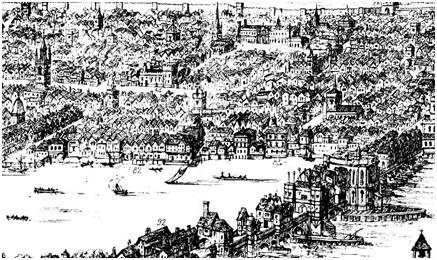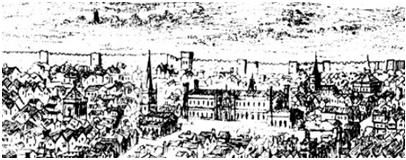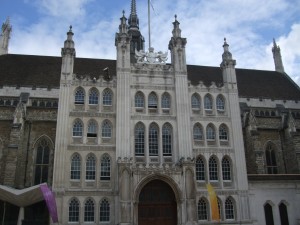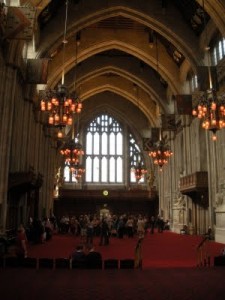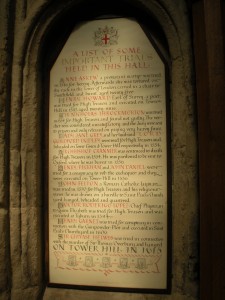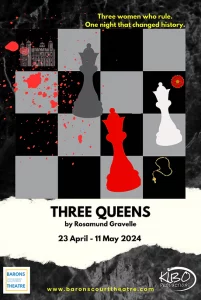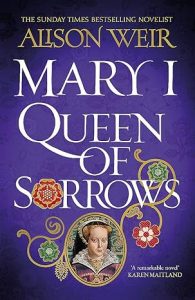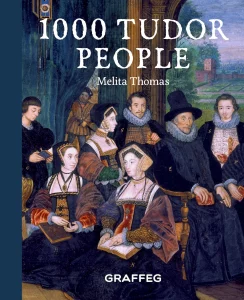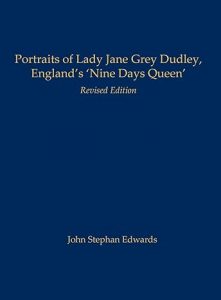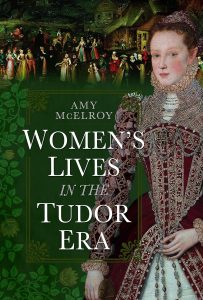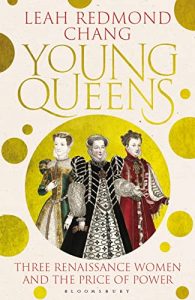The trial of Lady Jane Dudley
On 13 November 1553 Lady Jane and Guildford Dudley were tried at the Guildhall in London.
Ives writes that ‘when eventually it came, Jane’s trial was deliberately demeaning. She and the other accused were commoners. Not for them the privacy of a boat to Westminster; their trial was set for London’s Guild Hall. This meant a mile walk through the busy streets of the city and gave the government an opportunity to make the most of the humiliation of defeat. Four hundred halberdiers were on duty, not to guarantee safety but to demonstrate power. First on this via dolorosa came the officer carrying the great axe with the blade turned away from the prisoners to show that for a short time they would still be innocent in the eyes of the law. Cranmer and his keepers came first, next Guildford and his escort, then Jane between two guards and with two gentlewomen behind her and finally the Dudley brothers.’ (p.251, Ives)
De Lisle describes how ‘Guildford was dressed dashingly in a black velvet suit slashed with white satin. Jane, behind him, had chosen plain black, and strikingly, she was carrying an open prayer book in her hands with another, covered in black velvet, hanging from her waist. It was a public statement of Protestant piety. (p.282, de Lisle)
According to Ives, Jane and Guildford were charged with high treason for ‘taking possession of the Tower and proclaiming Jane while she faced the additional charge of ‘signing various writings.’ (p,252, Ives)
The author of ‘The Chronicle of Queen Jane and of Two Years of Queen Mary, and Especially of the Rebellion of Sir Thomas Wyat’ described the procession from the Tower.
‘The xiijth daie of November were ledd out of the Tower on foot, to be arrayned, to yeldhall, with the axe before theym, from theyr warde, Thomas Cranmer, archbushoppe of Canterbury, between (blank)
Next followed the lorde Gilforde Dudley, between (blank)
Next followed the lady Jane, between (blank), and hir ij. Gentyllwomen following hir
Next followed the lorde Ambrose Dudley and the lorde Harry Dudley.
The lady Jane was in a blacke gowne of cloth, tourned downe; the cappe lined with fese velvet, and edget about with the same, in a French hoode, all black, with a black byllyment, a black velvet boke hanging before hir, and another boke in hir hande open, holding hir.’ (p.32, Gough)
Henry Machyn (a citizen and Merchant Taylor of London) reported the event in his diary.
‘[The 13th of November were arraigned at Guildhall doctorCranmer, archbishop of Canterbury, the lord] Gylfford Dudlay,the sune of the duke of Northumberland, and my lade Jane ys wyff,the doythur of the duke of Suffoke-Dassett, and the lord Hambrosse Dudlay, [and the] lord Hare Dudlay, the wyche lade Janewas proclamyd [Queen]: they all v wher cast for to dee.’
From: ‘Diary: 1553 (Jul – Dec)’, The Diary of Henry Machyn: Citizen and Merchant-Taylor of London (1550-1563) (1848), pp. 34-50. URL: http://www.british-history.ac.uk/report.aspx?compid=45512 Date accessed: 26 October 2013.
The Chronicle of the Grey Friars reported that:
‘Thys yere the xiij. day of November the byshoppe of CantorberyThomas Creme (fn. 24) and lady Jane that wolde a bene qwene, and iij. of the Dudleyes (fn. 25) condemnyd at the yelde-halle for hye tresone.’
From: ‘The Chronicle of the Grey Friars: Mary’, Chronicle of the Grey Friars of London: Camden Society old series, volume 53 (1852), pp. 80-98. URL: http://www.british-history.ac.uk/report.aspx?compid=51590 Date accessed: 26 October 2013.
The author of ‘A London Chronicle’ wrote:
‘Vpon Monday, beynge ye xiij. day of Novembar, The archebyshope of Cantourbery, the lord Robert Dudleye, the lord GuylfordeDudley, husbond of ye lady Jane pretendyd quene, the lord HenrieDudley, youngest sone of ye sayd thre Dudleyes, and ye sayd ladyJane ye pretendyd queene, were all v. arreygnyd at ye Guylde hawllvpon highe treason, & so cast & adiudgyd to be drawne, hangyd,& quarteryd.’
From: ‘A London Chronicle: Mary’, Two London Chronicles from the Collections of John Stow (1910), pp. 27-43. URL: http://www.british-history.ac.uk/report.aspx?compid=81145 Date accessed: 26 October 2013.
Ambassador Simon Renard reported to the Emperor that:
Nov. 14. Vienna, Imp.Arch.E.20.Simon Renard to the Emperor.
‘To-day three sons of the Duke of Northumberland, Jane of Suffolk and the Bishop of Canterbury were taken to the hall at Cheapside, (fn. 13) and were there condemned to death. The only one of the Duke’s sons who has not been condemned is now my Lord Robert. When execution is to take place is uncertain, for though the Queen is truly irritated against the Duke of Suffolk, it is believed that Jane will not die.’
From: ‘Spain: November 1553, 11-15’, Calendar of State Papers, Spain, Volume 11: 1553 (1916), pp. 352-363. URL: http://www.british-history.ac.uk/report.aspx?compid=88505 Date accessed: 26 October 2013.
Julius Terentianus wrote to John Ab Ulmis on 20 November 1553 that:
‘On November the fourteenth Jane, formerly queen, together with the archbishop of Canterbury and all the sons of the duke of Northumberland, was arraigned before the judges at Whitehall; you know the place at London. Sentence of death was pronounced upon them all.’ (Letter CLXXXII, p. 374,Robinson)
Peter Martyr wrote to Henry Bullinger on 15 December 1553 that:
‘On the 14th of November the archbishop of Canterbury, together with the late queen Jane, and the sons of the duke of Northumberland, were brought to trial, and condemned to death…’ (Letter CCXXXVIII, p.507-8, Robinson)
Location
The Guildhall is located in the heart of the City of London.
‘Guildhall, which is situated at the centre of the City’s square mile on the site of an old Roman amphitheatre, is on the London’s great survivors. It was the only secular building to escape the Great Fire of London in 1666 and it survived the Blitz in 1940, though in both instances it lost its roof and windows. In the fifteenth century, it was the second largest edifice in London, after the old St Paul’s Cathedral, and the formidable Great hall and undercroft date from that period….everything beneath window-height is to the design of the original master mason, John Croxton, who built the Great Hall between 1411 and 1430. It is Gothic perpendicular in style, and an impressive 151 feet long, 48 feet wide and 89 feet high. (p.39, Lipscomb)
Tudor History of the Guildhall
1540 – Trial of Anne Askew.
1547 – Trial of Henry Howard, Earl of Surrey.
1553 – Trials of Lady Jane Dudley, Guildford Dudley, Henry Dudley, Ambrose Dudley and Thomas Cranmer, Archbishop of Canterbury
1554 – Trial of Sir Nicholas Throckmorton.
The Guildhall Today
Thank you to Nasim Tadghighi for letting me use her photographs.
Sources
Ives, E. (2009) Lady Jane Grey: A Tudor Mystery, Wiley-Blackwell.
Lipscomb, S. (2012) A Visitor’s Companion to Tudor England, Ebury Press.
De Lisle, L. (2013) Tudor: The Family Story, Chatto & Windus.
Nichols, J. G (ed) (1850) The Chronicle of Queen Jane and of Two Years of Queen Mary and Especially of the Rebellion of Sir Thomas Wyatt, Written by a Resident in the Tower of London, Llanerch Publishers
Robinson, H. (ed) (1846) Original Letters Relative to the English Reformation, Written during the Reigns of King Henry VIII, King Edward VI and Queen Mary (Volume One), University Press
‘Diary: 1553 (Jul – Dec)’, The Diary of Henry Machyn: Citizen and Merchant-Taylor of London (1550-1563) (1848), pp. 34-50. URL: http://www.british-history.ac.uk/report.aspx?compid=45512 Date accessed: 26 October 2013.
‘The Chronicle of the Grey Friars: Mary’, Chronicle of the Grey Friars of London: Camden Society old series, volume 53 (1852), pp. 80-98. URL: http://www.british-history.ac.uk/report.aspx?compid=51590 Date accessed: 26 October 2013.
‘A London Chronicle: Mary’, Two London Chronicles from the Collections of John Stow (1910), pp. 27-43. URL: http://www.british-history.ac.uk/report.aspx?compid=81145 Date accessed: 26 October 2013.
‘Spain: November 1553, 11-15′, Calendar of State Papers, Spain, Volume 11: 1553 (1916), pp. 352-363. URL: http://www.british-history.ac.uk/report.aspx?compid=88505 Date accessed: 26 October 2013.
Map of London http://en.wikipedia.org/wiki/File:Panorama_of_London_in_1543_Wyngaerde_Section_2.jpg
Date accessed 9 November 2013

